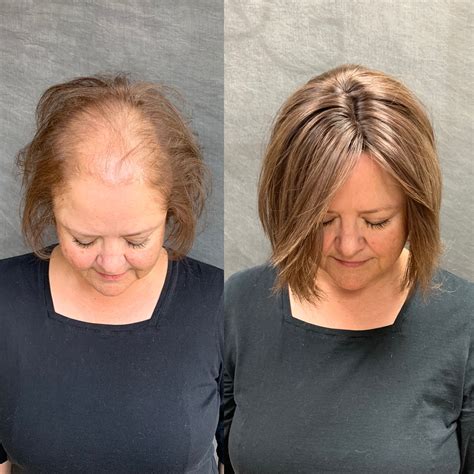Thinning crowns have become an increasingly prevalent concern, affecting both men and women. This condition arises due to a variety of factors, including genetics, hormonal imbalances, and aging. To combat this, hair toppers have emerged as a revolutionary solution, seamlessly enhancing hair volume and restoring confidence.

Understanding Hair Toppers
A hair topper is a partial hairpiece designed specifically for individuals with thinning crowns. Constructed from high-quality synthetic or human hair, it attaches to the existing hair, blending naturally and creating the illusion of thicker, fuller hair. Unlike wigs, toppers cover only the affected area, offering a more discreet and customizable solution.
Benefits of Hair Toppers for Thinning Crowns
- Instant Volume Boost: Toppers instantly add volume to thinning crowns, restoring a youthful and vibrant appearance.
- Natural Blend: Advanced hair topper technology ensures a seamless blend with your natural hair, creating an undetectable transition.
- Versatile Styling: Toppers allow for versatile styling options, enabling you to experiment with different looks and achieve the desired outcome.
- Hair Loss Confidence: By concealing thinning areas, hair toppers instill a renewed sense of confidence and self-esteem.
Types of Hair Toppers
1. Base Type:
- Capless Toppers: Lightweight and breathable, these offer maximum airflow and a natural feel.
- Monofilament Toppers: Durable and long-lasting, they provide a realistic scalp appearance.
- Lace Base Toppers: Sheer and delicate, they create an invisible hairline and allow for intricate styling.
2. Hair Type:
- Synthetic Hair Toppers: Affordable and low-maintenance, they come in a wide range of colors and textures.
- Human Hair Toppers: More expensive but offer a natural look and feel, allowing for styling with heat tools.
Choosing the Right Hair Topper
Selecting the ideal hair topper involves considering several factors:
- Base Size: Match the base size to the size of your thinning area for a snug fit.
- Hair Color and Texture: Choose a topper that aligns with your natural hair color and texture to ensure a seamless blend.
- Hair Density: Select a topper with the appropriate hair density to achieve your desired volume and coverage.
Application and Maintenance of Hair Toppers
Application:
- Section your hair and place the topper over the thinning area.
- Use hair clips or adhesive tape to secure it in place.
- Style your hair to blend with the topper and create a natural look.
Maintenance:
- Brush your topper regularly to detangle the hair.
- Wash it with a specialized shampoo and conditioner designed for hairpieces.
- Avoid using heat styling tools directly on the topper’s base.
Strategies for Enhancing the Effectiveness of Hair Toppers
- Color Matching: Consult a professional stylist to achieve an exact color match between your natural hair and the topper.
- Proper Placement: Position the topper correctly to ensure it covers the thinning area seamlessly.
- Layering and Blending: Layer your natural hair over the topper’s edges to create a more natural transition.
Tips and Tricks
- Experiment with Topper Size: Try different topper sizes to find the optimal coverage for your thinning area.
- Secure it Firmly: Use a combination of hair clips and adhesive tape to ensure your topper stays in place securely.
- Avoid Direct Heat: Use a heat protectant spray before styling your natural hair near the topper.
Pros and Cons of Hair Toppers
Pros:
- Instant volume and coverage
- Customizable and versatile styling
- Non-invasive and natural-looking
- Convenient and easy to maintain
Cons:
- Requires some maintenance
- May not be suitable for extreme hair loss
- Can be expensive
Table 1: Hair Topper Base Types
| Type | Advantages | Disadvantages |
|---|---|---|
| Capless | Lightweight, breathable | May not be as durable |
| Monofilament | Durable, realistic scalp | Can be less breathable |
| Lace Base | Invisible hairline, intricate styling | Delicate, requires more care |
Table 2: Hair Topper Hair Types
| Type | Advantages | Disadvantages |
|---|---|---|
| Synthetic Hair | Affordable, low-maintenance | Less natural appearance |
| Human Hair | Natural look and feel, heat-styling | More expensive, requires more maintenance |
Table 3: Hair Topper Selection Considerations
| Factor | Considerations |
|---|---|
| Base Size | Match to thinning area size |
| Hair Color and Texture | Align with natural hair |
| Hair Density | Determine desired volume |
Table 4: Hair Topper Enhancements
| Strategy | Description |
|---|---|
| Color Matching | Consult a professional for an exact match |
| Proper Placement | Position topper correctly for seamless coverage |
| Layering and Blending | Layer natural hair over topper edges to blend |
Conclusion
Hair toppers have revolutionized the approach to thinning crowns, offering a non-invasive and effective solution to regain hair volume and enhance confidence. By following the recommendations outlined in this article, individuals can achieve natural-looking and undetectable results, boosting their self-esteem and embracing a renewed sense of beauty.
